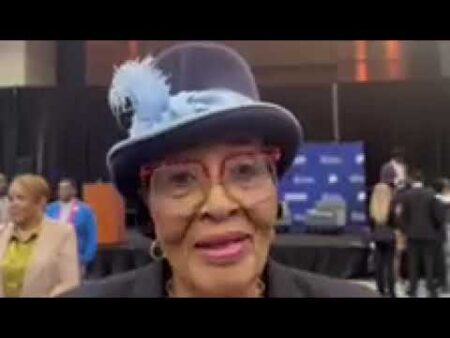What do Cesar Chavez, Ayn Rand, and Harold Washington have in common? They are among the 69 people featured in Adam Brooks’s public art project Freedom Wall, which has been installed on the building at 325 W. Huron since 1994. The text-based installation, which is viewable from the Brown Line’s Chicago stop, has undoubtedly been viewed by many thousands of people over the years—but not for much longer. The parking lot in front of the wall is being developed, which means the project will soon be hidden by another building.
In the lead up to the 1992 U.S. presidential election, Brooks, a longtime professor at Columbia College Chicago and one-half of the collaborative conceptual art duo Industry of the Ordinary, began thinking about putting together a project around the idea of freedom. “Obviously in America in particular, it’s the land of the free,” he says. “The word ‘freedom’ gets bandied around so much, you know, who’s going to be against freedom? But the idea of what freedom was was really interesting to me, because obviously there are as many interpretations of that as there are people.”
He was inspired by the work of conceptual artists like Barbara Kruger and Jenny Holzer, who often make text-based, public works. He was especially drawn to the way Holzer’s use of text seemed to have multiple voices. “I was interested in that notion of not taking one particular stance, but actually opening up a project to multiple participants with multiple viewpoints,” he says.
The presentation of the work is in tune with the straightforward text pieces of both Kruger and Holzer. The names appear in list form, in white enamel letters on a massive black vinyl sheet—72 feet high by 15 feet 6 inches wide—all capitalized in the simple sans-serif font Helvetica. The lettering was done by hand by painter Bob Morales of the Indiana company Billboards Inc. There’s no artist signature or title or explanation—there was once a description at the base but it’s long since disappeared. If a viewer is interested in learning more about the work, they have to Google or otherwise research it.
To come up with the names, Brooks surveyed a politically broad range of people, asking them to provide the names of up to three people, from throughout history, that they felt embodied the idea of freedom. He asked friends and colleagues, solicited responses at Rhona Hoffman Gallery (where he showed at the time) and used the then-burgeoning Internet. He got connected to middle and high school students across the country through the Electric Schoolhouse, a network of teachers who were early adopters of the Web, and messaged random strangers through America Online, where users had public profiles that listed their political affiliation.
“I felt that it was critically important for the project to be viewed as not just another piece of liberal activism, to include as many voices from across the political spectrum as possible,” he says. “It may not be fair and balanced, but it certainly was broad enough and eclectic enough ultimately, in order to ask some important questions about what freedom is, what it means to be free, who decides how we define that.”
That’s how the list ended up with names like Rush Limbaugh—whose radio show was widely popular at the time, juxtaposed against Anita Hill. Or photographer Robert Mapplethorpe following Ronald Reagan. Some names make the project hyperspecific to that moment in time. If it were made today, it’s unlikely that there would be many nominations for comedian Lenny Bruce or Czech politician and dissident writer Václav Havel or Dr. Death himself, Jack Kevorkian. The names appear in the order of how many votes they received, with one blank line representing those who couldn’t choose, and potentially allowing viewers to insert their own choice.

The site of the project, in River North, was around the corner from Hoffman’s gallery at the time; she helped facilitate securing the spot, which was then owned by developer and philanthropist David Ruttenberg. (It is now owned by RiverNorth Capital Management.)
I took the el to the site on a recent Sunday. It’s still viewable from the Chicago Brown Line platform, though the lot in front is fenced off and filled with huge blue cranes and other construction equipment. It’s harder to see from street level, though you can spy the work through gaps in the fencing. Brooks isn’t entirely sure when construction of the new building will begin, though it seems imminent. “I love the idea of it slowly disappearing rather than being removed,” he says. The work, still in excellent condition after 28 years, will technically remain on the wall. And if the new developer leaves a gap between the buildings, it’s possible that motivated viewers will still be able to catch a glimpse of it with a flashlight.
That potential future is exciting to Brooks—who has always liked that the project takes a little bit of work to understand. “It’s about asking questions, not answering,” he says. “Certainly, with my work with Industry of the Ordinary for the last couple of decades, that’s always been our approach: to leave things open-ended, to ask questions, to not insult the intelligence of the audience by spoon-feeding them, to ask the audience to do some work on their own. That for me has always been critically important and I think this piece has always functioned in that way.”
Related STories
Zoom in: River North
Adam Brooks’s Freedom Wall has been tattooed to the side of 325 W. Huron in River North for nearly 20 years.
Mathew Wilson and Adam Brooks
When Mathew Wilson left Chicago three years ago, taking his wife and new baby to his native England, he thought he’d left his adopted city and his days as a performance artist behind for good. “I came to think that I had been deluding myself–surrounded by other artists deluding themselves–and that one day I’d grow…
Music of the hemispheres
The CSO’s Katinka Kleijn premieres a duet for cello and brain waves
Did you know? The Reader is nonprofit. The Reader is member supported. You can help keep the Reader free for everyone—and get exclusive rewards—when you become a member. The Reader Revolution membership program is a sustainable way for you to support local, independent media.









